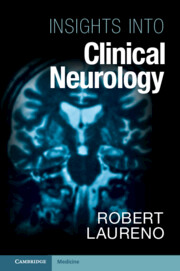Book contents
- Insights into Clinical Neurology
- Insights into Clinical Neurology
- Copyright page
- Dedication
- Contents
- Preface
- Acknowledgments
- Chapter 1 The Amnesic Syndrome
- Chapter 2 Aphasia, Apraxia, and Agnosia
- Chapter 3 Spurious Symptoms and Behaviors
- Chapter 4 Hallucinations
- Chapter 5 Grasping and the Grasp Reflex
- Chapter 6 Asterixis
- Chapter 7 Discussion of the Upper Motor Neuron Syndrome
- Chapter 8 Some Aspects of the Lower Motor Neuron Syndrome
- Chapter 9 The Limbic System
- Chapter 10 Vibration Sensation, the Posterior Columns, and Related Topics
- Chapter 11 Transneuronal Effects
- Chapter 12 Spinal Nerve Roots
- Chapter 13 Ischemic Hypoxic Encephalopathy
- Chapter 14 The Liver–Brain Relationship in Wilson Disease
- Chapter 15 Wernicke Disease
- Chapter 16 Delayed Neurologic Disorders after Toxic or Metabolic Insults
- Chapter 17 Transolfactory Spread in the Pathogenesis of Meningoencephalitis
- Chapter 18 Neurologic Disorders in Endocarditis
- Chapter 19 Secondary Abscess Formation in Primary Brain Lesions
- Chapter 20 Progressive Multifocal Leukoencephalopathy: The Early Years
- Index
- References
Chapter 20 - Progressive Multifocal Leukoencephalopathy: The Early Years
Published online by Cambridge University Press: 27 July 2023
- Insights into Clinical Neurology
- Insights into Clinical Neurology
- Copyright page
- Dedication
- Contents
- Preface
- Acknowledgments
- Chapter 1 The Amnesic Syndrome
- Chapter 2 Aphasia, Apraxia, and Agnosia
- Chapter 3 Spurious Symptoms and Behaviors
- Chapter 4 Hallucinations
- Chapter 5 Grasping and the Grasp Reflex
- Chapter 6 Asterixis
- Chapter 7 Discussion of the Upper Motor Neuron Syndrome
- Chapter 8 Some Aspects of the Lower Motor Neuron Syndrome
- Chapter 9 The Limbic System
- Chapter 10 Vibration Sensation, the Posterior Columns, and Related Topics
- Chapter 11 Transneuronal Effects
- Chapter 12 Spinal Nerve Roots
- Chapter 13 Ischemic Hypoxic Encephalopathy
- Chapter 14 The Liver–Brain Relationship in Wilson Disease
- Chapter 15 Wernicke Disease
- Chapter 16 Delayed Neurologic Disorders after Toxic or Metabolic Insults
- Chapter 17 Transolfactory Spread in the Pathogenesis of Meningoencephalitis
- Chapter 18 Neurologic Disorders in Endocarditis
- Chapter 19 Secondary Abscess Formation in Primary Brain Lesions
- Chapter 20 Progressive Multifocal Leukoencephalopathy: The Early Years
- Index
- References
Summary
Raymond Adams recognized a patient as having a clinically unique disease. On autopsy the brain revealed unique neuropathology. On microscopy Byron Waksman, an immunologist, noted inclusion bodies in oligodendroglia. Astrom, Mancall, and Richardson named the entity Progressive Multifocal Leukoencephalopathy (PML). Gabriele Zu Rhein and Sam Chou used electron microscopy to demonstrate virus in the cells. Later Zu Rhein provided fresh brain to Druard Walker. He and Billie Padgett grew the virus in cell culture to prove that PML was in fact a viral disease. These many investigators contributed to the early understanding of this disease.
Keywords
- Type
- Chapter
- Information
- Insights into Clinical Neurology , pp. 97 - 100Publisher: Cambridge University PressPrint publication year: 2023

